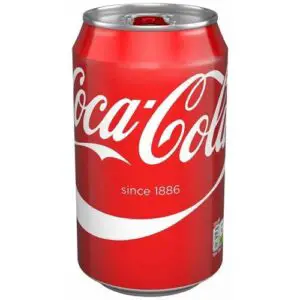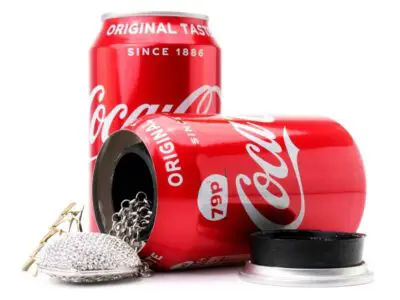Coca-Cola is one of the most popular soft drink brands in the world, and its signature product is the iconic Coke can. The Coke can has become an integral part of popular culture, recognized by its unique shape and design. However, beyond its aesthetic appeal, the coke can dimensions play a crucial role in its functionality and marketing.
In this article, we will explore the various aspects of Coke can dimensions, including its history, manufacturing process, design elements, and impact on consumer behavior and the environment.
Standard dimensions of a Coke can

The standard dimensions of a Coke can refer to the typical size of a can of Coca-Cola. The standard dimensions are as follows:
- Height: 4.83 inches (12.3 cm)
- Diameter: 2.13 inches (5.4 cm)
- Volume: 12 fluid ounces (355 milliliters)
These dimensions have become widely accepted as the standard size for a soda can in the United States and other countries. The dimensions of the Coke can are carefully designed to fit comfortably in the hand, making it easy to hold and drink from.
The can is also designed to fit in most cup holders and vending machines, making it convenient for on-the-go consumption. Additionally, the standard dimensions of Coke can have a significant impact on its packaging and transportation, as well as its marketing and branding.
How Coke can dimensions have changed over time
The dimensions of Coke can have undergone several changes over time in response to various factors, such as consumer preferences, manufacturing processes, and marketing strategies.
When Coca-Cola was first introduced in 1886, it was only available in glass bottles. However, with the increasing popularity of soda in the mid-20th century, Coca-Cola began experimenting with alternative packaging options, including cans. The first Coke can was introduced in 1955 and was smaller than the standard size we know today. It was only 7.5 ounces and had a different design.
Over time, the size of the Coke can increase to its current standard size of 12 ounces in response to consumer demand for larger servings. Additionally, the dimensions of Coke can be adjusted to optimize its manufacturing process and reduce costs. For example, changes in the shape of the can have made it more efficient to produce and transport.
The design of the Coke can has also undergone changes over time to reflect marketing and branding strategies. For example, in 2013, Coca-Cola introduced a new design for its cans that featured a more dynamic and modern design with the iconic Coke logo more prominently displayed.
In recent years, there has been a growing concern over environmental sustainability, and companies such as Coca-Cola are exploring ways to reduce the environmental impact of their products. As part of this effort, Coca-Cola has introduced smaller-sized cans, such as 7.5 ounces, as an alternative to the standard 12-ounce can.
Overall, the dimensions of Coke can have changed over time in response to a variety of factors, including consumer demand, manufacturing efficiency, marketing strategies, and environmental sustainability.
The materials used to make a Coke can
The materials used to make a Coke can have evolved over time, but the current standard for Coke cans is aluminum. Aluminum is a lightweight, durable, and easily recyclable material, making it ideal for packaging soda and other beverages.
The manufacturing of aluminum cans involves several steps, including rolling, punching, and shaping the metal into the desired dimensions. The aluminum sheets are first rolled to the appropriate thickness, then cut into circles that will serve as the tops and bottoms of the cans.
The circles are then punched to create the familiar ridged edges and shaped into the cylindrical form of the can. The cans are then washed, coated with a protective lining, and filled with the desired beverage.
Also, the protective lining on the inside of the can is made of a food-grade polymer that prevents the beverage from coming into contact with the aluminum and affecting the taste. The lining also protects the can from corrosion and damage.
In addition, aluminum is an environmentally friendly material, as it is 100% recyclable and can be infinitely reused without losing its quality or properties. Recycling aluminum cans requires significantly less energy than producing new cans from raw materials, making it an eco-friendly option for packaging. Coca-Cola is committed to sustainable packaging practices and aims to use 50% recycled content in its packaging by 2030.
In addition to aluminum, other materials such as steel and plastic have been used to make soda cans in the past, but aluminum remains the most popular and widely used material for Coke cans today.
The manufacturing process of a Coke can
The manufacturing process of a Coke can involve several steps, starting with the production of aluminum sheets and ending with the finished product, ready to be filled with Coca-Cola or other beverages.
The manufacturing process typically involves the following steps:
- Rolling: The aluminum sheets are rolled into the desired thickness and width.
- Punching: The aluminum sheets are cut into circles using a punching machine.
- Shaping: The circles are then shaped into the cylindrical form of the can using a shaping machine.
- Washing: The cans are washed to remove any debris or contaminants.
- Coating: The cans are coated with a protective lining on the inside to prevent the beverage from coming into contact with the aluminum and affecting the taste. The lining also protects the can from corrosion and damage.
- Printing: The cans are printed with the desired design using a printing machine.
- Filling: The cans are filled with Coca-Cola or other beverages using a filling machine.
- Sealing: The top of the can is sealed using a seaming machine.
- Quality control: The finished cans are subjected to quality control checks to ensure that they meet the required standards.
Once the cans have passed quality control, they are packaged and shipped to retail stores and other outlets for sale.
The manufacturing process of a Coke can is highly automated, with advanced machinery and technology used to ensure consistency and efficiency. The process is designed to produce large quantities of high-quality cans in a cost-effective and sustainable manner. Coca-Cola is committed to sustainable packaging practices and aims to reduce waste, improve recycling rates, and use more recycled materials in its packaging.
The weight of a Coke can
The weight of a Coke can can vary depending on the size and material of the can. The standard 12-ounce Coke can made of aluminum typically weighs around 15 grams or 0.53 ounces.
Aluminum cans are known for their lightweight and durable properties, making them a popular choice for packaging beverages like Coca-Cola. The lightweight nature of the cans also makes them easy to transport, reducing shipping costs and environmental impact.
The weight of a Coke can can also have an impact on recycling rates and sustainability. Lightweight cans require less energy to transport and recycle, making them a more environmentally friendly option. Additionally, lightweight cans can help reduce the overall amount of waste generated by beverage packaging.
In recent years, Coca-Cola has introduced smaller-sized cans, such as 7.5 ounces, as a way to offer consumers a smaller serving size option and reduce the overall environmental impact of its packaging. These smaller cans weigh less than the standard 12-ounce can, further reducing the environmental impact of the packaging.
Overall, the weight of a Coke can play an important role in the manufacturing, transportation, and sustainability of the packaging. The lightweight and durable properties of aluminum cans have made them a popular choice for packaging beverages like Coca-Cola, and efforts to reduce the weight of the cans can have a significant impact on sustainability and environmental impact.
Variations in Coke can dimensions across different countries

Coke can dimensions can vary across different countries due to differences in consumer preferences, packaging regulations, and manufacturing standards.
For example, in the United States, the standard Coke can is 12 ounces and has a diameter of 2.6 inches and a height of 4.83 inches. In Europe, however, the standard Coke can is 330 milliliters, which is roughly equivalent to 11.2 ounces and has a diameter of 2.6 inches and a height of 4.8 inches. In some countries, like Mexico, the standard Coke can is 355 milliliters, which is equivalent to 12 ounces but has slightly different shapes and dimensions.
These variations in Coke can dimensions can be attributed to a number of factors, including differences in consumer preferences for serving sizes, local regulations regarding packaging, and differences in manufacturing standards.
In addition to standard Coke cans, Coca-Cola also offers a variety of packaging sizes and shapes in different countries, including bottles, cans, and even pouches. These packaging variations allow Coca-Cola to tailor its products to local preferences and provide a wide range of serving sizes and options to consumers.
Despite these variations, Coca-Cola strives to maintain consistent quality and brand recognition across its products worldwide. This is achieved through careful design and manufacturing processes, as well as the use of standard branding and packaging materials.
The impact of Coke can dimensions on packaging and transportation
Coke can dimensions can have a significant impact on packaging and transportation, affecting factors such as material usage, transportation costs, and sustainability.
The dimensions of a Coke can can influence the amount of material needed to produce the can, as well as the amount of space required for transportation and storage. For example, a smaller can may require less material to produce, reducing the overall environmental impact of the packaging.
Also a smaller can may also require less space for transportation and storage, reducing shipping costs and environmental impact.
In addition, the dimensions of a Coke can can impact the efficiency of packaging and transportation. The size and shape of the can can affect how many cans can be packed into a case or onto a pallet, influencing the amount of product that can be transported at once. This can impact transportation costs and carbon emissions associated with shipping.
Coca-Cola has recognized the importance of packaging and transportation efficiency and has implemented measures to reduce the environmental impact of its packaging.
This includes using lightweight materials, such as aluminum, and introducing smaller can sizes to reduce material usage and transportation costs. The company has also implemented programs to increase the use of recycled materials in its packaging, further reducing the environmental impact.
Overall, the dimensions of a Coke can can have a significant impact on packaging and transportation, influencing factors such as material usage, transportation costs, and sustainability. By carefully designing its packaging and transportation processes, Coca-Cola can reduce its environmental impact and improve the efficiency of its operations.
The role of Coke can dimensions in marketing and branding
Coke can dimensions play an important role in marketing and branding, as they are a key aspect of product packaging and design.
The dimensions of a Coke can can impact how the product is perceived by consumers, influencing factors such as serving size and product value. For example, a larger can may be perceived as having greater value than a smaller can, while a smaller can be seen as a more convenient option for on-the-go consumption.
In addition, the design and dimensions of a Coke can can be used to reinforce the brand identity and create a unique visual appeal. Coca-Cola is known for its iconic red and white design, and the dimensions of the can are carefully designed to showcase the branding and messaging.
For example, the shape of the can may be used to highlight the Coca-Cola logo or other branding elements, while the color scheme can be used to create a bold and memorable visual impact.
Coca-Cola also uses packaging variations and limited edition designs to create a sense of novelty and exclusivity, further enhancing the brand appeal. For example, the company may release limited edition cans with unique designs to coincide with holidays or special events.
Overall, the dimensions of Coke can play an important role in marketing and branding, influencing how the product is perceived by consumers and reinforcing the brand identity. Through careful packaging design and branding strategies, Coca-Cola can create a unique and memorable product experience for its customers.
The influence of Coke can dimensions on consumer behavior
The dimensions of a Coke can can have a significant influence on consumer behavior. The size, shape, and design of the can can impact the way consumers perceive the product and can even affect their purchasing decisions.
One aspect of can dimensions that can influence consumer behavior is the size of the can. Larger cans may be perceived as offering better value for money, while smaller cans may be perceived as more convenient for on-the-go consumption. The size of the can can also impact portion control, with larger cans potentially leading to overconsumption.
The shape of the can is another dimension that can affect consumer behavior. Cans with unique shapes or designs may stand out on store shelves and attract consumer attention. Additionally, cans with ergonomic designs may be easier to grip and open, making them more appealing to certain consumer groups.
The design of the can is also an important dimension that can impact consumer behavior. The colors, graphics, and branding used on the can can influence the way consumers perceive the product and the brand. For example, a can with bold colors and a distinctive design may be perceived as more exciting or trendy than a plain, unbranded can.
Overall, the dimensions of Coke can can play a significant role in shaping consumer behavior and influencing purchasing decisions. Marketers and product designers must carefully consider these dimensions when developing packaging and branding strategies to appeal to their target audience.
The environmental impact of Coke can dimensions
The dimensions of Coke cans can have a significant environmental impact. The materials used to manufacture the cans, the size of the cans, and the disposal of the cans can all contribute to environmental issues.
One environmental concern related to the dimensions of Coke cans is the amount of aluminum used to make them. Aluminum production requires significant amounts of energy and produces greenhouse gas emissions.
Also, larger cans require more aluminum, which can contribute to increased environmental impacts. Additionally, the disposal of aluminum cans can lead to litter and pollution, particularly in areas without effective recycling programs.
The size of Coke cans can also impact their environmental footprint. Larger cans require more resources to produce and transport, which can contribute to increased greenhouse gas emissions and energy consumption. Additionally, larger cans may lead to overconsumption and increased waste, particularly if consumers are not able to finish the entire can.
To mitigate the environmental impact of Coke can dimensions, companies can explore alternative materials and designs. For example, companies can develop more sustainable packaging materials, such as biodegradable or compostable materials, or explore reusable packaging options.
Furthermore, companies can also consider reducing the size of their cans or offering a range of sizes to accommodate different consumption needs.
Overall, the dimensions of Coke cans can have a significant environmental impact, and it is important for companies to consider these impacts when designing and manufacturing their products.
Conclusion
If you want to know the coke can dimensions, then you are just in the right place. The dimensions of Coke cans can have both consumer behavior and environmental implications. The size, shape, and design of the can can influence the way consumers perceive the product and may impact their purchasing decisions.
At the same time, the materials used to manufacture the cans, the size of the cans, and the disposal of the cans can all contribute to environmental issues. To mitigate these impacts, companies must carefully consider the dimensions of their cans and explore alternative materials and designs that prioritize sustainability.


